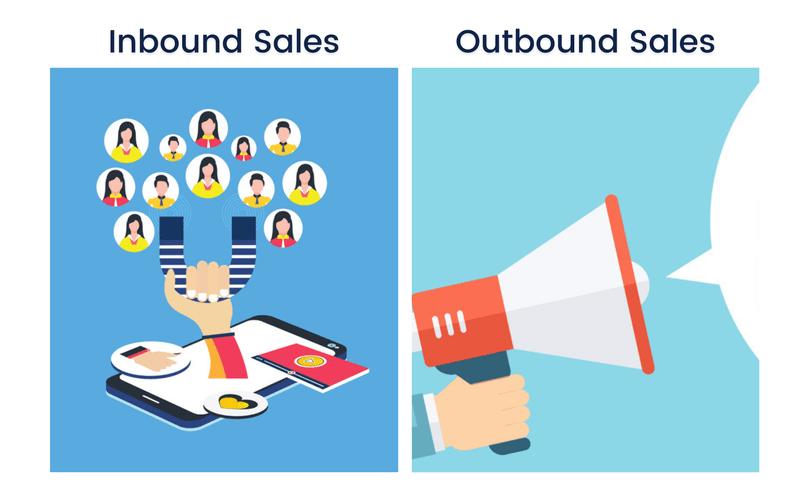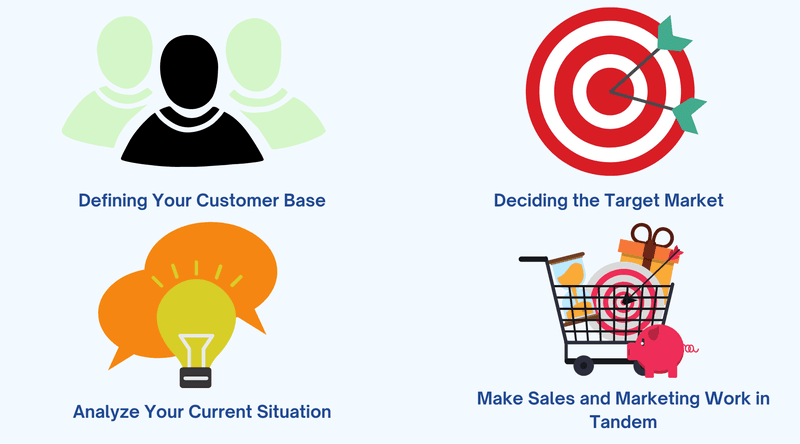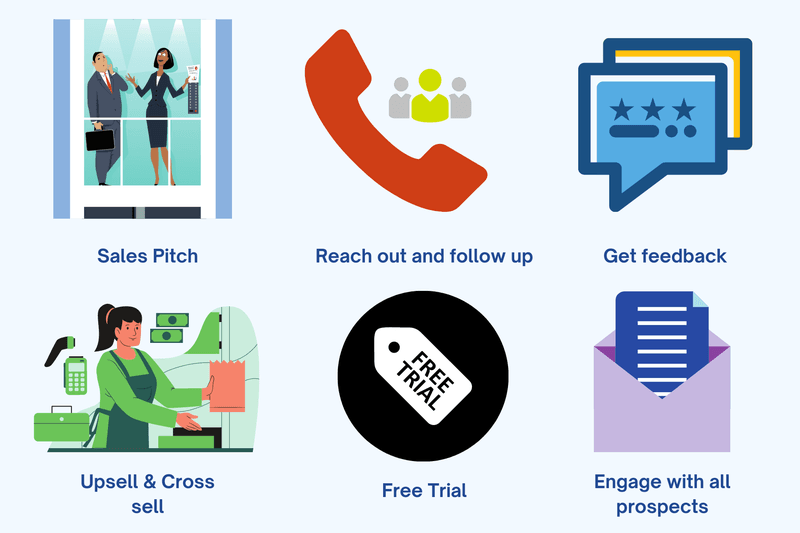Sales. The word conjures up images of numbers, targets, and pressure. At the same time, these components are indeed integral to sales. Having a great product is not enough if you are not sure whom to sell it to. To use a cliched analogy, you will never make money if you sell a comb to a bald person. It is essential to understand that there is a science behind the chaos. And this science of sales targeting is exactly what we will unravel in this piece.
What is Sales Targeting?

A sales strategy is a plan that focuses on the goals of the business. Furthermore, it also outlines how to achieve those goals. One can say that the sales strategy is like a guiding light that informs the sales team about a firm’s decisions, actions, and plans.
Another way of defining sales strategy is the prioritization of deals most likely to result in sales, and it is a subset of a businesses’ overall strategy. The difference between the two is that while a sales strategy looks merely at increasing revenues, a business strategy also views reducing costs.
A successful sales strategy works consistently. However, one must remember that these strategies have to be optimized continuously for best results.
The essence of sales targeting is the fact that it is audience-centric. So one must always think from the customers’ point of view.
What Are The Types of Sales Targeting?
Broadly speaking, there are two types of sales targeting: Inbound Sales and Outbound sales. We will explore these targeting strategies in some depth here.

Inbound Sales
This involves driving the prospects to your website. The focus of inbound sales is to create personalized experiences for the buyers. Here the attention shifts to understanding the requirements of the customers and fixing their pain points.
In inbound sales targeting, the audience gains awareness of your product through blog posts, social media, and other marketing material. Then once the audience has warmed up to your product, they will approach you for a demo. Here salespeople act as consultants, and they educate the prospect about the product and address his concerns.
Although most people tend to confuse inbound and inside sales, inside sales are when the sales activity happens remotely, through phone or emails. Inbound sales are about a different approach to selling. In inbound sales, there is a lot of emphasis on the quality of leads.
Outbound Sales
Outbound sales are those where a salesperson reaches out to an individual. This is done to generate interest and eventually sell a company’s products or services. Some strategies that are used in outbound sales are cold calling, email marketing, and social selling.
Outbound sales is a traditional way of reaching out to prospects. But that does not mean that it is an outdated method to reach out to potential buyers. Outbound sales consist of the following steps-
- Identification of target customers
- Lead Generation
- Outreach and qualifications
- Meetings
- Closing the deals
Outbound salespeople must do their homework on the firm and its potential pain points to increase their chances of success.
Secondly, every interaction should be tied to an outcome, and it is also crucial that the pitch be personalized as per the stakeholders. Finally, newer methods of selling have to be embraced.
What Are The Sales Targeting Steps?
Sales targeting consists of several steps. Let us examine them in detail below.
Initial Steps of Sales Targeting

Defining Your Customer Base
The first step in a sales targeting strategy is to define an ideal customer. This is often the most crucial and difficult step in the entire process, and hence it becomes essential to get it right. One has to assess how the potential customers will receive the product or service.
However, for this exercise to be successful, one has to determine the viability of the product or service.
Once the viability of the offering has been established, sales teams then get to work on deciding the buyer personas. Various factors come into play when creating a buyer persona, such as:
- Age: The buyer’s age is critical in determining whether the product’s end-user is the actual decision-maker.
- Gender: The gender of the buyer is important as it helps in finalizing the USP of the product along with the messaging
- Income: The income is a vital parameter as it is an indicator of purchasing power
- Lifestyle: Does your target buyer have a frugal or affluent lifestyle, or is he somewhere in the middle
- Location: The rules, regulations of a place also affect buying decisions.
- Preferences: Consumer tastes have a big say in the success of a product.
Instead of creating generic profiles, work on a story for each of your personas so that the team can relate to potential customers in a better way.
Deciding the Target Market
The finalization of the buyer personas is now complete. Good. The next logical step in sales targeting is to zero in on a target market. To do this, one must examine aspects such as
- Saturation levels of a market segment.
- The issues the current offerings in the market address.
Once you have identified the target market, one must get down to understanding the pulse of the customer. This can be done through customer surveys and interviews.
Analyze Your Current Situation
This step helps you assess risks and opportunities. It is an exercise that can be carried out in-house, and one can also hire an agency or a consultant depending on the budget and time frame. This activity can be carried out using a simple SWOT analysis or any other framework.
Performing this study in a structured manner will help one understand the strengths and differentiating factors of the firm vis-a-vis the industry.
Make Sales and Marketing Work in Tandem
Here’s how the sales and marketing teams efforts are recognized across firms

Many times in an organization, it is noticed that the sales and marketing teams work in silos. Consequently, there is a lot of discord between the marketing efforts and the actual sales results.
There has to be constant communication between the sales and the marketing teams to ensure that everyone is on the same page. This is especially important when one has to decide – what constitutes a qualified lead.
The marketing team should generate qualified leads using case studies, product brochures, client testimonials.
At this stage, the leads are known as Marketing Qualified Leads or MQL’s. These MQL’s are further nurtured by the demand generation team before being handed over to the sales team.
Advanced Steps of Sales Targeting

The steps explained above are the initial ones involved in sales targeting. Now we move further to the trickier ones:
Selecting the Right Channels
Deciding on the target customers and markets is one thing, and making sure your product reaches them is another. This makes channel selection a crucial part of the sales targeting process.
Channel selection impacts the selling costs, revenues, and market reach. The choice of the channel depends on the product or service, the sales environment in the firm, and the type of sales team present.
Performance Metrics
These are quality and quantity-based measurements. They can be used to track the performance of the sales program as a whole and individual team members. Examples of some performance metrics are:
- Number of new customers
- Ticket size or deal size
- Duration of the deal (for B2B businesses)
- Sales per region
- Sales per rep
Deliver Excellence Through Sales Targeting Consistently

An organization has to meet its business goals regularly to succeed in the long run. For that to happen, it is necessary to have a sales targeting strategy that repeatedly produces results.
Here we will look at the ingredients of sales targeting that separate the winners from the also-rans.
The Sales Pitch
This is the unique message that your sales team delivers to the target customers. It should be memorable and straightforward, and the message should help establish an emotional connection with the customer.
An effective sales pitch proves that one is knowledgeable about the customer’s issues. Therefore it is no surprise that an effective sales pitch increases conversion rates and, as a result, enhances the other sales metrics as well.
Reach Out and Follow Up
A prompt response to customer queries is a vital factor in conversions. As buyers are more informed these days, they will likely try out various solutions before deciding. In such a scenario, the salesperson who first reaches out to the customer is more likely to close the deal.
Similarly, regular follow-ups are a key part of sales strategy. It is necessary to remind the prospect that initial communication could have been overlooked, providing closure to the conversation.
Get Feedback
Your customers are your biggest advocates, and therefore it makes all the more sense to get feedback from them. The relevant points from this can then be incorporated into the product roadmap, and doing so will help retain existing customers.
Moreover, it will enhance your brand’s reputation and can lead to referrals.
Upsell and Cross-sell
Like many things in life, the Pareto principle applies to businesses as well. 80% of your revenues will come from 20% of your customers, and therefore it is essential to provide your existing clients with a superior customer experience to enjoy doing business with you.
Free Trials
No prospect will be willing to make a significant investment without a free trial of the product or service. Free trials are an excellent way for people to get familiar with the product. The free trial period also allows the sales team to understand the customer’s requirements and set up training sessions accordingly.
Engage With All Prospects
Everyone might not be interested in buying your products or services, and that is perfectly fine.
However, you can still send updates about your offerings, newsletters, and other relevant information (provided they haven’t unsubscribed, of course!). This will help in aiding top-of-mind recall.
Why Are Sales Targeting Important?

We have now seen the steps involved in sales targeting. Moreover, we also know what it takes to create a winning sales targeting strategy. Let us now understand why this process is essential.
It helps you get your offerings in front of the right people.
A proper sales targeting strategy gets you the right kind of customers, and it also gives your business the exposure that it needs. This, in turn, makes it easier to connect with prospects and pitch your product.
Enhances the productivity of sales teams.
The sales team should focus their energies on prospects that have a better chance of converting as a business. This is exactly what a better sales targeting system helps achieve. Conversion of warmer leads results in better numbers for the entire team and the organization as a whole.
Quantity over Quality.
Quality of leads is far more critical to the sales targeting process than the quantity. This is a mantra that should drive your sales teams. It is always better to work with clients that appreciate and understand the value of what your firm brings to the people. Upselling and cross-selling to such clients is an easier task resulting in larger ticket sizes.
This approach also ensures that the team does not deviate from its core customers and adopts a spray and pray approach.
Achieves customer delight.
Following a well-defined sales, targeting strategy helps a firm in developing a deep understanding of its customers. Furthermore, this allows your product team to fine-tune its offerings for your customer base. As a result, the brand strengthens its position in the market and carves out a niche.
In Conclusion
Sales targeting is a process that works on the following levers – company vision, revenues, ideal customer profile, budgets, and value proposition. One must remember to measure the results at periodic intervals.
Subsequently, the necessary optimizations have to be made to achieve the desired outcomes.
Adaptability is the key to success in the long run. One needs to be aware of the changing preferences of their consumer base, the evolution of technology and modify their sales targeting strategy accordingly. In short, the success of your sales strategy is pivotal to the success of your business.

Ranu Kumari is a Professional Writer and a Marketing enthusiast who currently runs her own Marketing Consultancy, LatitudeBOX. She has written promotional articles for multiple brands and has published her work in Scopus indexed journals. She is passionate about expressing her thoughts and ideas to connect with her readers in a voice that they understand.

Hi,
Sales Targeting done as per the industry then hit hard on those industries which more likely to buy first.
What is your thought on this.
Targeting the correct audience per industry is the way to go. Thanks for the comment!